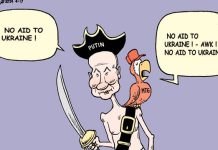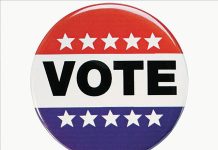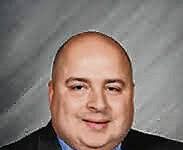By Harry McCawley
Taffy and Dan Schroer traveled almost 500 miles from their Columbus home last month to visit the John Deere Museum in Waterloo, Iowa. They wanted to learn more about the history of the international manufacturer of agricultural machinery.
Ironically the museum served to remind them of another history, one much closer to their Columbus home. It was in the form of a letter written almost 50 years ago to William Hewitt, who then was chief executive officer of the Waterloo-based company.
His correspondent was Lady Bird Johnson, first lady of the United States and wife of President Lyndon Johnson. The letter was a thank-you note typed on White House stationery, acknowledging a floral gift.
It was a handwritten postscript at the bottom that got the attention of the Columbus visitors and took them back almost a half century to a night when Lady Bird Johnson visited Columbus with “a few friends.” She made a mark on Columbus that night in 1967, but as the postscript demonstrated, Columbus had an effect on her.
“Mr. Hewitt, I’ve just returned from Columbus, Indiana, and was every bit as impressed with it and Mr. Miller as you are.”
The first lady arrived Sept. 21, 1967, and departed the next day, but in that brief time she put Columbus on the map. She didn’t come alone. She was accompanied by a number of spouses of members of her husband’s administration, including Muriel Humphrey, wife of Vice President Hubert Humphrey, and Jane Freeman, wife of Agriculture Secretary Orville Freeman.
Then there was the press. The first lady’s tour of Columbus was covered by 93 news organizations from around the world, including the New York Times, the Washington Post, the Dallas Morning News, the Chicago Tribune, both major wire services and Time magazine. Even Helen Thomas, veteran wire service correspondent for United Press International, came to Columbus that night.
The visit also was featured in a 20-second segment that aired later on NBC’s Huntley-Brinkley Report. The producer for that segment was Aline Saarinen, widow of Eero Saarinen, the architect of such iconic local buildings as North Christian Church and the former Irwin Union Bank building. The city was part of a national tour of American communities undertaken by Johnson to highlight the beautification of America.
In the case of Columbus, the visit stood as a tribute to the architects who had designed some of the most striking examples of contemporary architecture in the country and to J. Irwin Miller, the Columbus industrialist and philanthropist who had fostered that effort.
In 1967 Columbus was in the midst of an astounding renovation of its built environment. The architects who had created designs here were already well-known on the world stage and just about every one of them came to Columbus to be saluted. It was one of the largest single gatherings of world-class architects in Columbus. I.M. Pei was here. So were Dan Kiley, Alexander Girard, Gunnar Birkerts, John Dinkeloo, Robert Venturi, Norman Fletcher and John Carl Warnecke.
The first lady didn’t get to see all of their works because of the crowded schedule, but what she did see was enough to make an impression. She was given tours of North Christian and First Baptist churches and in a ceremony under the lights at Lincoln Elementary School dedicated a marker that made note of her visit.
The tour ended late in the evening at a dinner in the courtyard of McDowell Elementary School where 500 guests — including a number of notable local Republicans, such as Robert Stewart who served as state GOP chairman when Lyndon Johnson swept to a landslide victory in the 1964 presidential campaign — were the audience for a performance from the opera “Falstaff.”
While there were a number of formal aspects to the visit, there also were “down home” touches. Columbus was limited as to accommodations, and the largest hotel — the Imperial House — was given over to White House staff and the visiting press contingent. The featured guests of honor were hosted by local families in their homes. Johnson had a sleepover at the Miller home on Highland Way, while Humphrey was hosted by Cummins executive Richard Stoner and his family. Freeman was the guest of Columbus farmer Donald Thompson, who also served as county chairman of the Democratic Party.
Most of the architects who had come to Columbus to be saluted were put up by local families as well.
The party ended the next day but not before a call was placed to the Miller home asking to speak to the first lady. When told that she was not yet up and about, the caller asked that his call be returned and passed along congratulations on the “good press” that her visit to Columbus had drawn. The caller was the president of the United States.
Lady Bird Johnson did, indeed, get “good press” for that September 1967 visit. So did Columbus.
Harry McCawley is the former associate editor of The Republic. He can be reached at [email protected].




